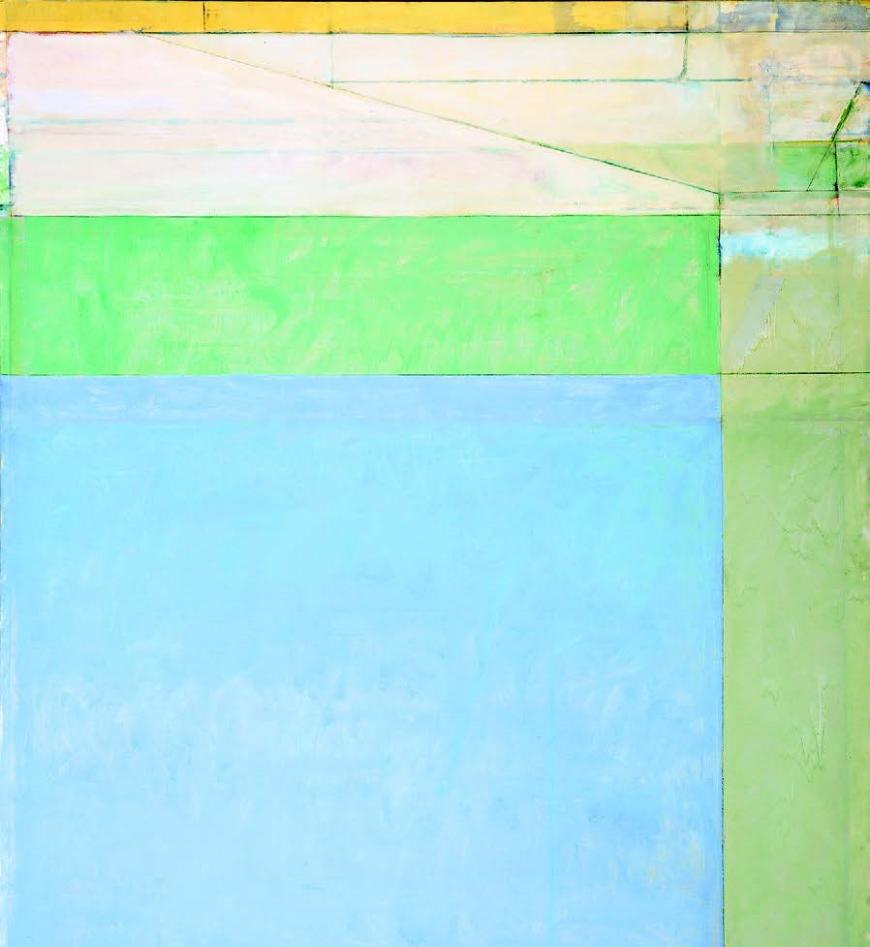Richard Dibin (Portland, 1922– Berkeley, 1993)
Ocean Park 66, 1973
Oil on canvas, 236.22 cm × 205.74 cm. Buffalo Albright Knox Gallery

S. Bancroft, Richard Dibenn: Ocean Park Series, Exhibition Catalog, Prest Press, New York, 2011.
From 1967, when Di Binne was 45, until 1985, he worked on a touring exhibition of paintings in Ocean Park. Dibenn moved to California in 1966, where he named a large collection of his works based on a site near the Santa Monica area, which included 145 paintings on large canvases, research drawings and drawings on paper, collages, single prints, and prints.
In those years when pop imagery or minimalism in all its forms prevailed, hosting an exhibition of landscape paintings seemed to be an untimely approach. Dibenn stayed in a studio, drawing only what he saw through the studio window. His approach was very different from the creative approach that emphasized "social" participation at the time. If his approach is not a conservative approach, it is of a regressive nature. DeiBenn abandoned his previous iconographic style and wanted to focus on the light, shape, and restore the basic qualities of color in an absolute way.
The basic pattern of this series is that the drawings are separated by a simplified fence. It is usually the upper or next part to depict a window (or, in other cases, the frame of the window, or a miniature painting of the wall). The other section shows elements of the exterior landscape, such as the sloping roof of the house and the leaves of palm trees. The final third part shows the glass and the bright translucent surface on which it reflects. Taken as a whole, this is a vision that the author can get from a corner of his studio, creating things that also have simple geometric figures, such as triangles and quadrilaterals, and after these geometric figures, one can find some perspective lines and some three-dimensional elements (such as the beams, trees and buildings of the house).
Dikorn freely reorganized these elements, and his work had both an abstract and figurative style. He neither constructed overly complex landscapes nor cared too much about the architectural significance of his works. The large color zones hint at scenes of different depths, and the painter uses these color zones to use his endless imagination to practice painting to the fullest.
Dibbon was an important painter because he showed that painting was first and foremost an attempt to solve the problems of shape, color, and creation, and that one could also experiment with the possibilities of a given situation, such as repetition, deletion, or superposition, or a balance between the search for the perception of the figure, the meaning of the shape, and the contingency of creation.
In this way, Dibenn confined his work to two major European traditional styles (abstraction and figurative), and he also combined specific scenes from the Gulf region. Dibenne re-explored the practice of depicting landscapes while following strict geometric requirements, and his work is reminiscent of Mondrian's great works, as well as the personal style of Milton Avery or, more difficult to understand, Edward Hope. In a complex combination of dark blue, green water, gray and rose, color becomes a complex layered object. This is clearly reminiscent of Matisse's palette (the work was exhibited at the 1966 Los Angeles Retrospective). Dibbon did not forget the abstract expressionist style and color paintings when he created, and his works, like Rothko's works, have extremely strong color collisions.
Excerpt from Contemporary Art
Global Art History
[Italy] by Alexandre del Popo
Translated by Zhou Binbin
Shanghai Sanlian Bookstore Phoenix Yili
The problem in the art world today is that art can make people think of many things, but in particular, art is not like anything. We know what art means, but we're not sure what it is.
The book is accompanied by exquisite pictures that show the reader the development of modern art.
Synopsis
Contemporary Art is one of the books in the "Global Art History" series. This book introduces readers to the development of contemporary art from the 20th century to the present, taking the rise of a new generation of artists represented by Pollock as the source, selecting iconic events in contemporary art to expound, and revealing the roots of some interesting phenomena unique to contemporary times.
Introduced from Italy, the "Global Art History" series is a new, open and systematic encyclopedia of world art that introduces readers to artistic creations from different periods and countries.
About the Author
Alexander del Popo is a professor at the University of Udine in Italy, a researcher of art history, and the author of several works on art history, including Contemporary Art.
Translator Profile
Zhou Binbin, graduated from Beijing Second Chinese College of Foreign Language and Literature, majoring in Italian Language and Literature. She has translated manuscripts for a number of cooperative units, participated in international level examination projects and obtained excellent results, translating "Art in the Romantic Era", "Art in the Napoleonic Era", "Vatican Tombs" and so on.
| all rights reserved, please do not reprint | without authorization
| if you have copyright related questions, you can contact the background to deal with |
★ Phoenix One Force | creator ★ of the ultimate reading experience